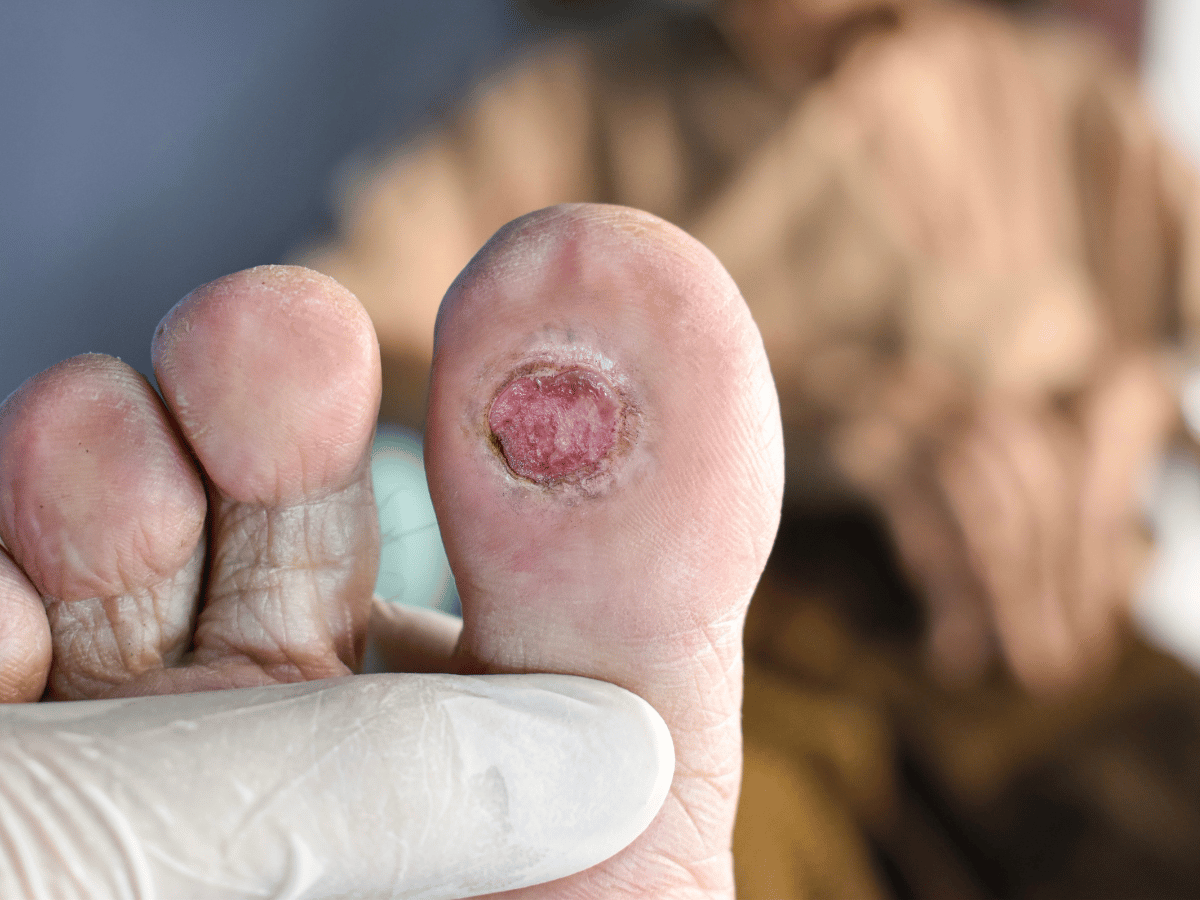
Imagine walking barefoot on gravel and not feeling a single sharp edge. Now imagine developing a wound from a minor cut or sore that never heals and even risks amputation. That’s the stark reality for many living with diabetes who experience what’s known as a diabetic foot ulcer.
At South Florida Multispecialty Hospital, we’ve seen firsthand how devastating diabetic foot ulcers can be. But we also know they can be prevented, detected early, and treated effectively with the right care.
A diabetic foot ulcer is an open wound usually located on the sole of the foot or near pressure points that doesn’t heal properly. These ulcers form because diabetes impairs the body’s natural healing mechanisms. When nerve damage (neuropathy) dulls sensation and poor blood flow limits healing, even small injuries can escalate rapidly.
Roughly 15% of people with diabetes will develop a foot ulcer at some point. That’s not a small crowd. It’s one in nearly every seven.
So, why do ulcers happen in the first place?
For many, it starts with diabetic neuropathy. Think of it as your body’s early warning system failing. When nerves are damaged due to chronic high blood sugar, they lose their ability to signal pain. You may have a blister or cut without ever noticing it.
Next, there’s peripheral arterial disease (PAD), another common issue in diabetes. PAD narrows blood vessels in your legs and feet, reducing oxygen and nutrients where they’re needed most for healing.
Combine these issues with other factors like:
And you’ve got a perfect storm waiting to happen.
The challenge with diabetic foot ulcers is how easily they can go unnoticed. But here are the signs that should never be ignored:
If you spot any of these symptoms, don’t wait. Early detection saves limbs and lives.
The earlier we identify a foot ulcer, the simpler the treatment. Here’s what we do during a foot evaluation:
We encourage at-risk individuals to have regular foot screenings. And not just once a year but every 3 to 6 months if you’ve had previous ulcerations or neuropathy.
Treating diabetic foot ulcers isn’t just about putting on a bandage.
Effective treatment typically involves these components:
Managing the wound is only half the battle. Managing the cause like high blood sugar and circulation issues is equally critical.
At South Florida Multispecialty Hospital, we never approach diabetic foot ulcers in isolation. Why? Because no one specialty has all the answers.
That’s why our care model includes:
When care is combined across disciplines, healing happens faster and recurrence is less likely.
The most effective strategy against foot ulcers? Prevent them from forming in the first place.
Here’s what we recommend to every patient:
Foot ulcers aren’t just painful, they’re dangerous.
According to national health data, diabetic foot ulcers precede over 80% of lower-limb amputations in diabetic patients. That’s a sobering statistic. Even more concerning, minor foot wounds that go untreated can double the risk of hospitalization.
It’s important we recognize ulcer-related complications early, including:
The future of diabetic foot ulcer care is bright. Today’s advances go far beyond antibiotics and bandages:
As these innovations evolve, our hospital stays at the forefront, so our patients benefit the most.
If you or a loved one has diabetes and notice foot pain, numbness, wounds, or unusual symptoms on the feet, don’t wait. Getting seen early could be the difference between a simple treatment and lifesaving intervention. Contact South Florida Multispecialty Hospital today to schedule a diabetic foot screening with our expert team.
Diabetic foot ulcers are open wounds on the feet of people with diabetes. They typically occur due to poor blood supply and nerve damage, which impair healing and sensation.
Anyone with diabetes, especially those with neuropathy, poor circulation, foot deformities, or history of previous ulcers, is at increased risk.
Look for redness, swelling, drainage, discoloration, or visible sores on the feet—especially in pressure-prone areas.
Diagnosis involves a physical exam, neurological tests, blood flow assessments, imaging, and wound cultures.
Treatment includes wound care, infection control, offloading, advanced therapies, glycemic management, and follow-up care through a multidisciplinary team.
Yes, untreated ulcers can lead to severe infections, osteomyelitis, gangrene, and even require limb amputations.
Daily foot care, wearing protective footwear, managing blood sugar, avoiding smoking, and attending regular foot exams are effective preventive strategies.
Tight blood sugar control lowers the risk of ulcers and accelerates healing during treatment.
Collaboration among specialists leads to integrated care plans that treat root causes, monitor healing, and reduce complications or recurrence.
Quit smoking, eat a balanced diet, maintain a healthy weight, stay active, and monitor your feet daily.
Your well-being is our top priority. Reach out today to discover how our dedicated team can support your health journey.
Have questions or want to learn more? Use the form below to get started!
Connect with South Florida’s trusted multispecialty care team and take control of your health with compassion and convenience.
©2025 South Florida Multispecialty Medical Group. All Rights Reserved.